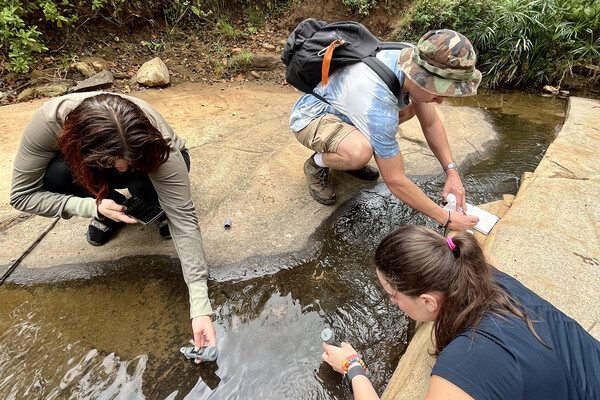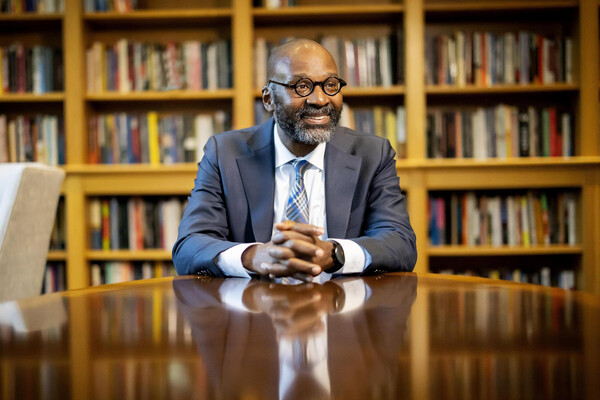
Griffin Pitt, right, works with two other student researchers to test the conductivity, total dissolved solids, salinity, and temperature of water below a sand dam in Kenya.
(Image: Courtesy of Griffin Pitt)

With the shared vision to transform the future of oral health care, Penn’s School of Dental Medicine and School of Engineering and Applied Sciences have united to form the Center for Innovation & Precision Dentistry (CiPD). The new Center marked its official launch on Jan. 22 with a virtual program celebrating the goals and plans of this unique partnership. Along with the Deans from both schools, the event gathered partners from throughout the University as well as invited guests, including the National Institute of Dental and Craniofacial Research Director (NIDCR) Rena D’Souza.
Conceived and brought to fruition by co-directors Michel Koo of Penn Dental Medicine and Kathleen Stebe of Penn Engineering, the CiPD is bridging the two schools through cutting-edge research and technologies to accelerate the development of new solutions and devices to address unmet needs in oral health, particularly in the areas of dental caries, periodontal disease, and head and neck cancer. The CiPD will also place a high priority on programs to train the next generation of leaders in oral health care innovation.
“We have a tremendous global health challenge. Oral diseases and craniofacial disorders affect 3.5 billion people, disproportionately affecting the poor and the medically and physically compromised,” says Koo, professor in the Department of Orthodontics and Divisions of Community Oral Health and Pediatric Dentistry, in describing the motivation to form the Center. “There is an urgent need to find better ways to diagnose, prevent, and treat these conditions, particularly in ways that are affordable and accessible for the most susceptible populations. That is our driving force for putting this Center together.”
“We have united our schools around this mission,” adds Stebe, Richer & Elizabeth Goodwin Professor in the Department of Chemical and Biomolecular Engineering. “We have formed a community of scholars to develop and harness new engineering paradigms, to generate new knowledge, and to seek new approaches that are more effective, precise, and affordable to address oral health. More importantly, we will train a new community of scholars to impact this space.”
A serendipitous connection born of Penn’s interdisciplinary research environment itself brought Koo and Stebe together more than five years ago, an introduction that would eventually lead to creating the CiPD.
Tagbo Niepa, now assistant professor at the University of Pittsburgh, came to Penn Engineering in 2014 as part of Penn’s Postdoctoral Fellowship for Academic Diversity, an initiative from the office of the Vice Provost for Research. His studies on the microbiome led him to reach out to Stebe and Daeyeon Lee (also at Penn Engineering), and to connect them to Koo, initiating collaboration between their labs.
“Tagbo embodies what we are trying to do with the CiPD,” recalls Stebe. “He had initiative, he identified new tools and important context, and he did good science that may help us understand how to interrupt the disease process and identify new underlying mechanisms that can inspire new therapies.” Niepa worked on applying microfluidics and engineering to study the oral microbiome and better understand how the interactions between fungi and bacteria could impact dental caries.
“Upon meeting Michel, we became excited about the possibilities of bringing talent from the two schools together,” notes Stebe. A 2018 workshop organized by Koo and Stebe and funded by Penn’s Vice Provost for Research explored the potential for expanding cross-school research. “We invited researchers from dental medicine and engineering as well as relevant people from the arts and sciences to see if we could find a way to collaborate to advance oral and craniofacial health,” says Koo. “That was the catalyst for the Center; after the workshop, we put together a task force which would become the core members of the CiPD.”
In addition to Koo and Stebe, the CiPD Executive Committee includes associate directors Henry Daniell, vice-chair and W.D. Miller Professor in Penn Dental Medicine’s Department of Basic & Translational Sciences; Anh Le, chair and Norman Vine Endowed Professor of Oral Rehabilitation in Penn Dental Medicine’s Department of Oral and Maxillofacial Surgery / Pharmacology; Andrew Tsourkas, professor in Penn Engineering’s Department of Bioengineering and co-director of the Center for Targeted Therapeutics & Translational Nanomedicine and the Chemical and Nanoparticle Synthesis Core; and Jason Moore, Edward Rose Professor of Informatics and director of the Penn Institute for Biomedical Informatics. The core members of CiPD include 26 faculty from across both Penn Dental Medicine and Penn Engineering, as well as from the Perelman School of Medicine and the School of Arts & Sciences.
“I’m thrilled that Michel and Kate initiated this coalition,” says Penn Dental Medicine’s Morton Amsterdam Dean, Mark S. Wolff. “It is exciting that we have so many partners across Penn that are interested in joining us in trying to make breakthrough science possible.”
“This Center exemplifies the best of Penn,” says Vijay Kumar, Nemirovsky Family Dean of Penn Engineering. “Combining different perspectives, producing new knowledge and translating it into real solutions is at the core of our collective mission.”
Three of the CiPD primary partners will play key roles in the Center’s funding opportunities to promote research, training, and entrepreneurship focused on translatable technologies to study disease mechanisms and to develop precision diagnostics and affordable therapeutics to promote oral-craniofacial health. They include Penn Health-Tech Center for Health, Devices and Technology, which will co-sponsor grants to support inter-school collaborations to both advance fundamental knowledge and accelerate the development of new diagnostic and therapeutic approaches Penn Institute for Biomedical Informatics(IBI), which has established the CiPD-IBI Fellowship for junior investigators to promote the application of artificial intelligence and machine learning in dentistry; and Penn Center for Innovation, which will co-sponsor a school-wide competition with students, residents, and graduate/postdoctoral fellows to pitch new ideas and solutions to address current clinical problems. The fourth primary partner, Penn Dental Medicine’s Center for Clinical and Translational Research, will support CiPD when research is ready to be tested in a clinical setting. CiPD has committed over $100,000 in matching funds to advance these initiatives.
The affiliated partners of CiPD are CT3N: Center for Targeted Therapeutics and Translational Nanomedicine, ITMAT: Institute for Translational Medicine and Therapeutics, and PICS: Penn Institute for Computational Science.
Both Koo and Stebe stress that the training programs they are developing at the CiPD will be fundamental to the transformational impact they hope to achieve. “We want to create a new and diverse cross-trained workforce of dentists, engineers, and data scientists to advance oral and craniofacial research and health care innovation,” says Koo. “We see this as a career-defining program where our cohort of talent leaves aware of the unmet clinical needs and regulatory hurdles and knows how to identify research areas in this interface and garner research funding to launch into academics or pursue industry/entrepreneurship opportunities.”
A grant is pending with the NIDCR that would fund the training program, which encompasses co-mentorships from both Penn Dental and Penn Engineering faculty as well as access to shared resources, facilities, and research centers at the schools and across the University.
“One of the most important ways we are going to make an impact is to train new talent in this space, incubated between the disciplines to adopt and adapt the rapidly emerging technologies and approaches to find new solutions to study, diagnose, and prevent or treat oral diseases,” adds Stebe.
While last week’s event was the official launch of the CiPD, the Center’s work is already well underway. The first CiPD-IBI Fellow has been selected, Alena Orlenko, who recently published a paper on using machine learning to better understand dental caries. And, in the realm of collaborative research between the two schools, studies are progressing that include, among others: microrobots that clear dental plaque from tooth surfaces and remove biofilms from root canals; customized N95 respirators that use 3D face scans for improved function and comfort; artificial intelligence to develop more effective antimicrobials; nanocarriers for drug delivery to precisely target bone diseases; and organ-on-chip technology, mimicking complex and dynamic structures to study oral diseases and new therapies.
NIDCR Director Rena D’Souza, who spoke at the launch event, expressed excitement for starting the Center at a time when she sees science and technology coming together like never before.
“We are already generating high impact science and building connections throughout the University, the profession, and industry. We want to challenge the status quo and generate the knowledge and new solutions that will benefit the society and improve oral health care,” says Koo. “We are just getting started, and we have the ambition in our heart for making a real impact for those who need the most.”
Beth Adams

Griffin Pitt, right, works with two other student researchers to test the conductivity, total dissolved solids, salinity, and temperature of water below a sand dam in Kenya.
(Image: Courtesy of Griffin Pitt)

Image: Andriy Onufriyenko via Getty Images

nocred

Provost John L. Jackson Jr.
nocred